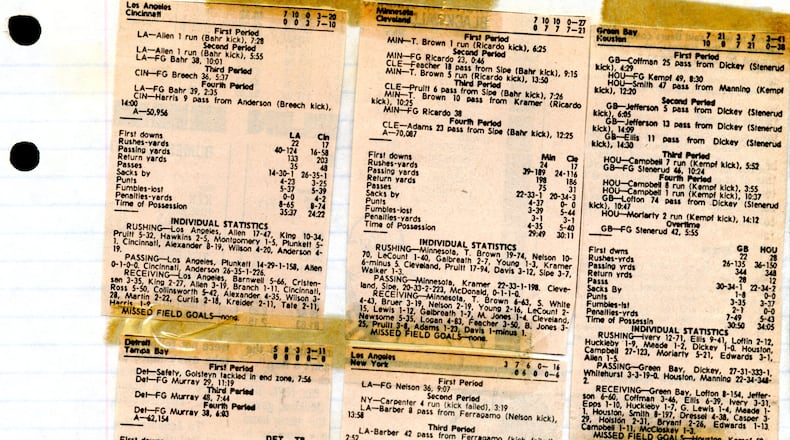You know fantasy football as one of the world's popular fall hobbies. You know it as a captivating, occasionally obsessive exercise among friends and strangers alike. You know fantasy football as a multi-billion dollar industry (roughly $7 billion a year, according to The Fantasy Sports and Gaming Association) that sometimes overshadows the NFL games themselves.
What you might not know: One of the earliest leagues, if not the first on the East Coast, was founded at Marist School in the early 1980s.
Marist student Scott Frank, alongside his classmates, read a Sports Illustrated article explaining rotisserie baseball. It motivated the group to start their own fantasy football league – one that included a heavy reliance on Channel 2 and The Atlanta Constitution – before the idea became a sensation.
Frank was among eight founding members, including Frankie Doherty, Chris Decherd, Mark Wesley, Glenn Gilbertti, Jay Dowlen, Gil Markham and Chris Daniel. They made their drafts a social event at a member’s house – a tradition that continues today – and developed a points-only scoring system.
Their rosters included three quarterbacks, four running backs, six receivers, two kickers and two defenses. The scoring format rewarded five points for a touchdown under 40 yards and 10 points for those exceeding 40 yards. Each receiver touchdown was worth 12 points. Running-back scores were valued at seven. Kickers produced 10 points for kicks at 46-plus yards, seven points for kicks between 36 to 45 yards, and five points for 35 yards or fewer. Defenses were rewarded for shutouts (15), touchdowns (10) and safeties (eight).
After creating a randomized draft order that flowed similarly to today’s arrangements (though obviously without the internet’s simplicity), Gilbertti made the first selection in 1983, taking quarterback Dan Fouts at No. 1. Frank, who won the first two titles, followed with kicker Rolf Benirschke.
Unlike today, the league couldn’t track its scoring live. That process wouldn’t be completed until each Monday morning, when players woke up and eagerly checked stats in The Atlanta Constitution. To cope with the waiting process, the friends would call local news affiliates to get ahead on some of their scoring.
They found particular help in a Marist product: Ernie Johnson Jr.
“On Sunday nights, we’d call the different local stations – Channel 2, 5, 11,” Frank said. “The one that cooperated the most by far was Channel 2, and Ernie Johnson, who was a recent graduate from the University of Georgia. He worked at the sports desk, we’d call, and he’d say, ‘Ernie Johnson, what can I do to help you?’ And we got pretty good at it because we did it every weekend. He’d say, ‘Give me your top five players and I’ll tell you what they did.’ That was it. Then we’d wait until Monday morning to look at the newspaper. It was the craziest thing when you think about how it is today.”
Johnson has since become one of the more recognizable names in sports, lauded for his work as host on TNT’s “Inside The NBA.” When Frank and company were calling, Johnson was in his second year with WSB and his first as the weekend sports anchor.
Those avenues helped make the league a resounding success. The friends became increasingly passionate. (“When you’re in high school, you have nothing else going on,” Frank said.) They developed relationships and bonds that have lasted through today.
They expanded the league after the first season, adding four members. Among the newbies was Dan Perez, who’s since become a staple of Marist sports. Perez, who attended Georgia Tech, has coached football and baseball at Marist for just over three decades. He credits the league for exposing him to a wide range of games beyond local broadcasting.
“It made me an even more avid sports fan, no doubt about it,” Perez said. “It was the most fun I’ve had being a sports fan. It was a bunch of friends, we just got into it, big-time. It wasn’t a bunch of money, it was more about the competitive ego in us, talking smack to each other. We capped how much money you could lose each week – I think $5 or $10 was the cap. … It was the infant stages of something that’s now exploded in popularity.”
Perez remembers his favorite pick: An anti-Georgia fan, he made bets with his buddies that Pittsburgh would top the Bulldogs in the 1982 Sugar Bowl. Thanks to quarterback Dan Marino’s last-minute touchdown throw, the Panthers did just that. Perez later drafted Marino when he was an NFL rookie in 1983.
Marino, a future Hall of Famer, would produce one of the best rookie seasons in NFL history with the Dolphins. Perez became a Marino fan and wore No. 13, a number that his nephews have since worn at Marist.
“It’s become a family deal,” Perez said, chuckling. “And it all goes back to that night that Marino threw a touchdown to John Brown (in the Sugar Bowl).”
Perez also recalled dialing the Bengals’ front office for the sake of his and Frank’s fantasy team. They were connected to the training room, sweet-talking their way into learning fullback Pete Johnson’s status for the coming game.
Lineups had to be set early, and Johnson’s supposedly injured ankle had them worried they’d be without their prized short-yardage back. An unthinkable phone call later, they found out his ankle was fine.
“We ended up getting that information, putting Pete Johnson in the lineup, and I think he ended up scoring three touchdowns that day,” Perez said. “And I was like, ‘Whatever it takes.’ We had to go to lengths like you wouldn’t believe to find that stuff out. Now, everything is so accessible.”
The Marist league continues in 2020. The members now use MyFantasyLeague.com, and winners’ names are engraved on a trophy. This season will mark Year 38.
“Looking back after 37 years, I feel lucky to have had such good friends to spend my Sundays,” said Doherty, one of two original members still participating. “It’s still like Christmas morning waking up on draft day, and there is no better feeling on Sundays when my team hits nirvana after a big day from my signature big-play combo.”
Doherty, a four-time champ and co-commissioner, added: “Being a Falcon fan all my life, I just hope Arthur Blank looks my way next year if Thomas Dimitroff blows another draft.”
While Marist’s league was among the earliest documented, fantasy football’s origins can be traced to 1962. It didn’t rise in national prominence until the ’80s. CBS launched the first fantasy website in 1997. They’re now commonplace, with the cyber sport taking off in ways Frank couldn’t have dreamed.
Yet one iteration began organically in metro Atlanta.
“I don’t know that we could’ve protected it, but we weren’t thinking of this thing being a world-wide phenomenon,” Frank said. “But it was pretty cool we were doing it before everyone else. It is amazing to think where we were and where it is now. It’s cool that we thought of something, figured out something before most everyone else.”
Perez added: “We all give Scotty Frank a hard time because he ended up becoming a patent lawyer, a brilliant, successful guy. But we’re like, ‘Scotty, you’re in the business of patents. How come you didn’t protect this idea of ours when we were high school renegades?”
About the Author
Keep Reading
The Latest
Featured




